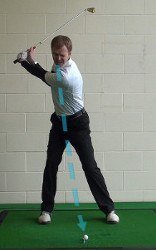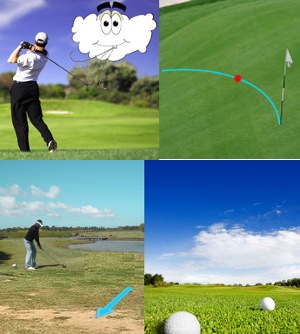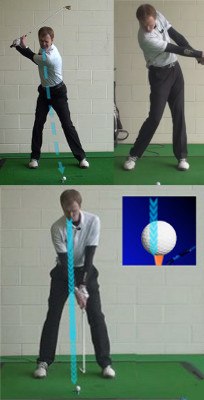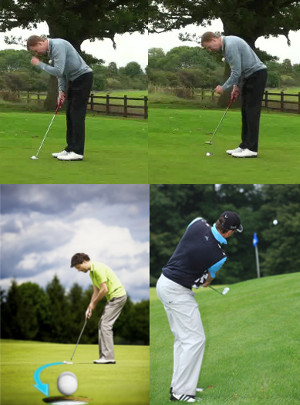By keeping your eyes level successfully, you can make the golf swing a lot easier – and much more consistent. This is a fundamental that is overlooked by many golfers, but it is important nonetheless. Not only is eye level a key fundamental in a quality golf swing, it is also a simple and defined point that you can use to focus your thoughts prior to hitting a shot.

You may not have given much thought to this golf swing fundamental before now, but it is certainly something that should be on your radar. Maintaining a level position with your eyes from the takeaway through impact and beyond is something that can have a powerful effect on your swing, and on your game as a whole.
What parts of your body do you think are most important during the golf swing? Your arms certainly have a crucial role to play, as do your legs and even your feet. But what about your eyes? It’s easy to forget about the job the eyes have to do but using them correctly is a big piece of the puzzle when trying to improve your performance. If you manage to master how your eyes work while on the course – both before and during the swing – you’ll almost certainly take a step forward in performance.
In this article, we are going to examine how the eyes should work in golf from a number of angles. Most likely, you are already doing well on some points, and you may have work to do in others. Don’t worry if you are making some mistakes currently with how your eyes behave on the course, as finding those mistakes will open up opportunities to improve.
| GOLF FIXES BY PGA PROS |
|---|
| Use Your Eyes Correctly To Play Better Golf | Video | Article |
| Your Eyes And The Golf Short Game | Video | Article |
| Eyes on the Back of the Ball for Better Contact | Video | Article |
| How To Use Your Eyes Before A Golf Tee Shot | Video | Article |
| Putting Stance, Align Eyes Over the Golf Ball to Straighten Out Putts | Video | Article |
| Why you Should Align Eyes Over the Golf Ball Senior Putting Help | Video | Article |
| Make Sure at Address you Align Eyes Over the Golf Ball Ladies Best Putting Tip | Video | Article |
| LESSONS |
|---|
| Read Greens With the Eyes of a Pro | Video | Article |
| When It Comes to Putting, The Eyes Have It | Video | Article |
| Better Ball Striking – Level Eyes | Video | Article |
| Top Four Tips Of Best Use Of Eyes In Golf | Video | Article |
| Better Ball Striking – Level Eyes In The Short Game | Video | Article |
| Improve Your Golf Shot Consistency – Eyes Under Shaft Line At Finish Lesson | Video | Article |
| The Relative Position of Your Eyes in Putting | Video | Article |
| Improve Ball Striking by Keeping Eyes Level | Video | Article |
| Improve Golf Ball Striking By Keeping Eyes Level | Video | Article |
| Keeping Your Eyes Level Is Important In Your Short Game Too | Video | Article |
| PRACTICE DRILLS |
|---|
| Distance Control Golf Drills: Putt with Eyes Open, then Eyes Closed | Video | Article |
| Putting-Pace Control Eyes Closed Golf Game | Video | Article |
| GOLF QUESTIONS |
|---|
| Right Hand Golf Tip: Why the Eyes Need to be Level for Best Ball Striking | Video | Article |
| Why Do Some Players Practice Their Golf Putting With Their Eyes Closed | Video | Article |
| How Can I Ensure My Eyes Are Over The Ball When Putting | Video | Article |
| How Can I Keep My Eyes Level And And How Will Effect My Golf Shots? | Video | Article |
| Putting Setup, Eyes In Relation To The Golf Ball | Video | Article |
Once you identify a weakness in your game, whatever that weakness may be, the only logical next step is to get down to work on fixing it once and for all.
All of the instruction in this article has been written from the perspective of a right-handed golfer. If you happen to play left-handed, please take a moment to reverse the directions as necessary.
— Your Eyes During the Swing
Let’s get started by talking about how your eyes should be working during the swing. Most golfers are so caught up thinking about things like swing plane, shoulder rotation, head position, and on and on, that they never stop to think about how their eyes are behaving. If you use your eyes incorrectly during the swing, you may be making things harder than they need to be.
On a basic level, the job of your eyes during the golf swing is quite simple – watch the ball until it is struck and sails off into the distance. That sounds easy enough, but it can go wrong in a number of ways. The points below will highlight some of the keys to keep in mind as you try to improve the way your eyes work while swinging the club.

- Pick a spot. So, you probably know already that you should be watching the ball as you make your swing. And that’s a good place to start, but what part of the ball are you watching? That might not seem important, but it really can help you focus and avoid letting your eyes drift as the swing develops. The precise spot on the ball that you choose to watch is up to you, and you might want to experiment on the range to pick a spot that makes you feel comfortable. As one option, you could watch the back of the ball, which is the part you will be trying to strike. Or, you could look right at the top of the ball, picking out a specific dimple or marking on the ball to focus your gaze.
- Don’t follow the club. It’s tempting to let your eyes follow the club back as you get your swing started. As you perform the takeaway, letting your eyes follow the club could lead to unwanted movement in your head. If your eyes are drifting right, it only makes sense that your head to drift in that direction, as well. It is at this early stage of the swing that you will be tempted to let your eyes drift, so pay particular attention to holding your eyesight still at this stage. If you make it through the takeaway without letting your eyes move away from the ball, it should be pretty easy to get through the rest of the swing without looking away.
- Keep your chin up. This is a tip that has more to do with your posture than your eyes, but all of these things are related. If you make such a point of looking at the ball throughout the swing that you drop your head and lose your posture, you’ll be hurting your cause in the end. Remember to keep your chin up and away from your chest at address so you have room to freely turn your shoulders as your swing. If you bury your chin down into your chest, your shoulder turn will be restricted, and it will be hard to make a free, powerful swing. Don’t make the mistake of thinking that since you need to keep your eyes down you also need to force your head down into an awkward position. It’s possible to look down at the ball comfortably while keeping your chin up and your back straight, and that’s what you should be striving to achieve.
- Eyes down for an extra moment. You don’t want to look up prematurely as you swing through the hitting area. This is an easy mistake to make, as you will be anticipating impact and feeling anxious about looking up to see where the ball is headed. This can be a costly error, however, as looking up early may pull your head and shoulders up away from the ball and out of the swing. When you are working on your swing at the range, make a point of keeping your eyes down all the way through impact until you are sure the ball is gone. Reinforcing this habit during practice will make it much easier to stay in that mode while on the course.
There isn’t a lot you need to learn about how to use your eyes when making a swing, as long as you remember the basics. You’ll want to keep your eyes on the ball throughout the swing, pick a precise spot on the ball to watch, and make sure you don’t look up prematurely. This is one of those points that you should keep in the back of your mind as you practice, and work on it intentionally from time to time just to make sure you don’t fall into any bad habits.
— Scanning the Course
One discussion regarding the use of your eyes on the golf course is the one we just had above – how they should behave during the swing. However, that’s not the only role that your eyes have to play, as they will also be used to scan the golf course and pick up various cues on where you should aim, how hard you should hit the ball, and on and on. Learning how to use your eyes to evaluate the course and spot both threats and opportunities is key to your development as a player.
Let’s walk through a few tips on what you should be watching for as you make your way around the course during any given round.

- Watch the wind. Okay – so you can’t technically see the wind, but you can see what the wind is doing to things like trees and flags. It’s always important to monitor the status of the wind as you play, since even a modest breeze can impact the flight of your ball. You will usually feel the wind at ground level if it is blowing, but your shot is likely to head well up into the air, where wind conditions may be different. If you are playing on a tree-lined course, or a course with at least a few trees around the property, look up to the tops of those trees for a little extra info on the wind conditions. Every additional piece of info you can get will be helpful, and this is an easy way to gain insight on how the wind may impact your shots.
- See all the slopes. Golf is a game of slopes. Rarely will you find a large section of a golf course that is completely flat, and the variation in the slope of the ground is one of the things that makes golf so much fun. Throughout your round, you should constantly be evaluating the slopes that might have an effect on your shots. Pretty much every golfer knows to watch the slopes on the greens when reading a putt, but you can use this strategy from tee to green. On the tee, look out into the fairway and determine if there are any meaningful slopes that you need to consider as you play your shot. For instance, a significant slope from right to left in the fairway may cause you to aim down the right so the ball can bounce and roll toward the middle. The same kind of strategy can apply to approach shots – play your shot to one side or another to let the slope help you get the ball closer to the hole. It’s also important to remember that the condition of the course will greatly impact how much the slopes are going to do to the ball when it lands. On a firm course, you’ll have to give the slopes plenty of respect, while a softer course will mean that you can take the ball a little straighter toward your targets without worrying as much about how it will bounce and roll.
- The condition of the turf. To play this game well, you need to understand the condition of the turf and adapt to it as necessary. Some of what you learn about the turf will be from the feel you get of walking on top of it, but you can also add to your knowledge by looking at it carefully throughout the day. Remember, the condition of the turf is going to change somewhat during the day as the temperature rises and falls and other weather conditions change. You might notice on a warm summer day, for instance, that the turf gets kind of bumpy and crusty late in the day as the grass grows and the turf dries out. Or, as a more obvious example, the turf will soften if rain moves in, so you’ll have to adjust to that change, as well.
- Observe the shots of others. This last point is an important one, and one which is missed by many amateur golfers. As you go through any round, you should be paying careful attention to the shots that the other players in your group are hitting. This is perhaps the best way of all to learn about the course, the conditions, and what to expect when you play your own shot. You might already be in the habit of watching other player’s putts to get an idea of the break, but there is more you can be doing. When another player in your group hits first, watch to see how the wind might affect the ball, or how the ball bounces when it lands. There is no excuse to make the same strategic mistake as another player when you see it play out right in front of you. As long as you are paying close attention, you can pick up an incredible amount of info from the other players in your group.
While rounds of golf can take a long time to complete – over four hours in a lot of cases – it’s wise to be taking in as much information as you can during that time. Pay attention to what is going on around you and learn for the right things to look for as you play. If you are focused on the task at hand, and open to learning from what your eyes are telling you, it’s possible to make this difficult game just a little bit easier.
— Practice Drills to Train Your Eyes
It’s always a good idea to use golf drills when you want to make any kind of specific improvement in your game. Whatever it is that you are trying to improve, you would be wise to find at least one or two drills that you can use to target that area. Simply thinking about getting better at something isn’t going to do you any good – you actually have to take action and get down to business in order to make progress.
In this section, we have two simple drills for you that should help you use your eyes properly as you swing. These drills are easy to incorporate into your normal practice routine, so give them a try during your next visit to the range.

- Practice swings with your eyes closed. While at the range, try making a swing or two with your eyes closed (not hitting a ball – just a practice swing). Without the use of your eyes, you will have to feel your way through the swing and trust your movements. Of course, you’ll need to be in a safe place to make a swing where you can be sure no one else will be getting in your way. After a couple of practice swings with your eyes closed, go back to hitting a few shots with your eyes open. You may find that it is easier to trust your swing and just keep your eyes on the ball, since you just got done making some swings where you weren’t looking at anything at all. You may be surprised to find just how much more connected to your swing you will feel after only a few repetitions of the eyes closed practice swing routine.
- See the tee. This is a drill that is designed to help you keep your eyes down on the hitting area all the way through impact. If you are practicing on grass, tee the ball up very low, so that the ball is basically resting on the turf, but it is technically perched on a tee. Then, hit your practice shot with the goal of seeing the tee under the ball as you swing through impact. Of course, to do so successfully, you’ll need to keep your eyes down on the ball as the club swings through. It might help to color the top of the tee with a bright marker, so it stands out from the surrounding turf. This is an easy way to practice the skill of keeping your eyes down on the ball through the shot. As long as you see the tee once the ball has left and before you have looked up, you’ll know that you did a nice job of keeping your eyes on the ball in the downswing.
You might find that these drills give you a newfound respect for how important it is to control the way your eyes work as you swing. You don’t need to do these drills every single time you visit the range, but trying them out from time to time can help keep you on track and correct any bad habits that you may have been developing.
— The Eyes and the Short Game
You won’t be surprised to learn that your eyes have an important role to play in the short game. In fact, it might even be more important to control your eyes here than in the long game, as the smallest details can make all the difference on short shots.
For starters, you will need to keep your eyes still, just as before. Some players will find this harder in the short game than the long game, since the hole is so close by. It will be tempting to just sneak a quick peek up at the hole before you actually strike the ball – and that peek could send your putter off line and the putt may roll by the side of the cup in the end. If you are going to reach your potential in the short game, on both chips and putts, you need to keep your eyes steady.

From there, you need to use your eyes properly in order to pick target lines and make decisions on how the ball will break. As a good rule of thumb, you want to evaluate all but the shortest of putts from at least two angles before you proceed. If you look from only behind the ball before hitting a putt, you are going to miss out on a big part of the picture. Take a moment to read the putt from behind the ball and behind the hole and you will have a much better idea of which way the slope is running.
It's also important to evaluate the uphill or downhill aspect of a putt or chip before hitting the shot. This tends to be the forgotten element as many players get wrapped up in whether the ball is going to turn left or right and forget to consider speed in the equation. If you don’t notice that a putt is downhill, for example, you are going to wind up hitting it much too hard. The best place to read the elevation change in a short game shot is halfway between the ball and the hole, a few steps to the downhill side of the line.
Finally, it’s a good idea to control your eyes in terms of not looking around too much at what is going on beyond your little ‘world’. If you let yourself get too distracted by other players, or whatever else may be trying to pull at your attention, you won’t be able to focus on the job at hand. The short game, perhaps more than any other part of the game, requires focus and attention to detail. Lock yourself in on the job at hand and use your eyes to evaluate slopes, turf conditions, and more. Once you pick a target and take your stance to hit the putt or chip, focus on a spot on the golf ball and keep your gaze down until the ball is on its way.
It may not be the first area of your game you think to improve but mastering how your eyes work on the course can have a powerful effect on your performance. We hope the tips and advice in this article will help you make some positive changes in how you use your eyes – and, with any luck, those changes should lead to lower scores. Good luck!






